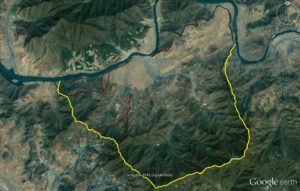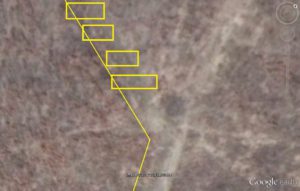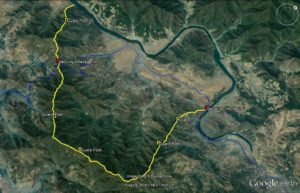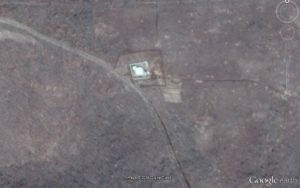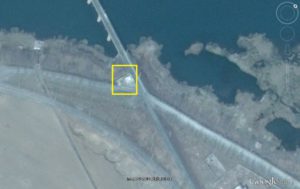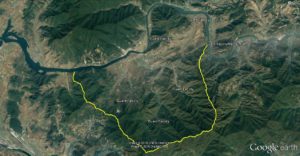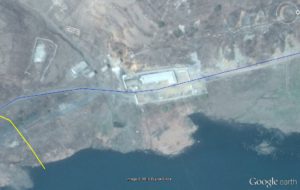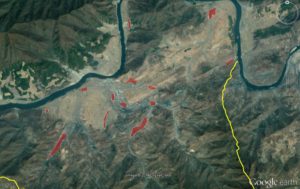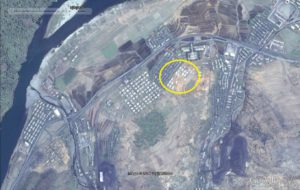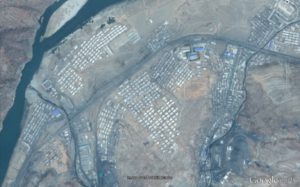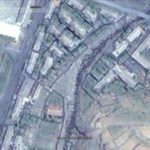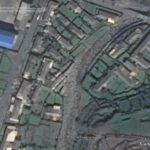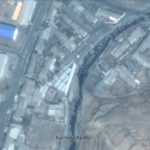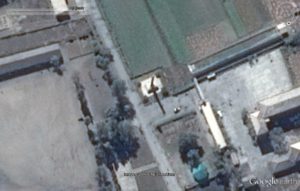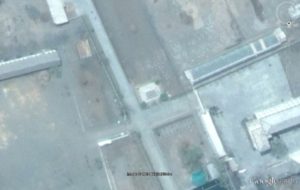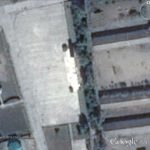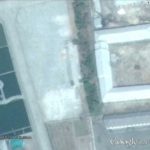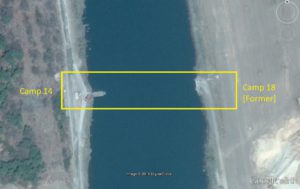The consensus among North Korea watchers (myself included) was that Camp 18 had been closed sometime in the late 2000s (between 2006 and 2011) [UPDATE: Camp 18 may have been moved to Tongrim-ri in neighboring Kaechon. I first wrote about the new prison camp here, though I did not know it was the remnants of Camp 18]. The coal mine located inside the camp, the Pongchang District Coal Mine (봉창지구탄광), was even featured on North Korean television on 2011-1-3, 2012-2-27, and 2012-10-20.
Recent satellite imagery of the camp featured on Google Earth (2016-3-30), however, indicates that a new prison camp has been opened on the site of the former prison sometime between 2013 and 2015. If a new prison camp has been been opened, it’s name and administrative classification remain a mystery, though I post some evidence and speculation below for your consideration….
New Security Perimeter
A new security perimeter has been built around the former Camp 18, and it is not built along the same path as the old Camp 18 security perimeter.
Pictured Above (Google Earth): The outlines of the new prison camp security perimeter (in yellow) and various historical security perimeters associated with Camp 18 (in black)
The difference between the security perimeter of the old Camp 18 and the new prison camp can be most clearly seen along the eastern and norther edges of the camp. Camp 18 had a security perimeter along the norther border, and remnants of it still remain, but the new prison camp does not yet appear to have a northern border (other than the Taedong River).
The new security perimeter appears to be composed of two barbed-wire fences held up by concrete posts.
The new security perimeter has five new guard posts along the mountain ridge and two new security checkpoints, one at each of the two transit points. The eastern security checkpoint appears to be the main entrance. The southern mountainous checkpoint appears to be for delivery of coal to the “famous” 2.8 Jikdong Youth Coal Mine Mine (2.8직동 청년 탄광) located outside the security perimeter.
Pictured Above (Google Earth: 2016-3-30): Security perimeter of prison camp (yellow line), five guard posts (yellow points), two transit checkpoints (red points), roads in/out of the camp (blue lines)
Here is a closeup of the new guard post at 39.546986°, 126.018297°. It was built between 2013-10-1 and 2015-4-4. You can also see the barbed wire perimeter running next to it.
There is also a guard post on the bridge that links the area with Camp 14, but this checkpoint appears to be a remnant of the former Camp 18.
New Guard Barracks?
There also appears to be six facilities (four that are new) that could serve as guard barracks scattered around the camp.
The guard facilities/barracks are located here: 1. 39.536004°, 126.051207° 2. 39.521812°, 126.079342° 3. 39.579655°, 126.080485° 4. 39.593158°, 126.115249° 5. 39.576379°, 126.131835°
The five facilities are very similar in construction. Here is a closeup of the facility that lies at the main entrance to the new prison camp:
Housing Razed
A substantial amount of housing was razed in the camp between 2013 and 2016, which would support the idea that “innocent” people were moved out of the camp perimeter (possibly to eastern neighboring Myonghak Coal Mine (명학탄광) or Tukjang Youth Coal Mine (득장청년탄관) which have both seen substantial housing growth starting in 2011). It is possible that once the “innocents” were moved to the neighboring coal mines, the Pongchang Coal Mine in the former Camp 18 could return to the exclusive use of prison labor.
In image above areas where houses were destroyed are outlined in red.
Below are images from neighboring Myonghak Coal Mine (명학탄광) which saw a housing boom starting in 2011. Were these people being removed from former Camp 18?
By 2014, this new housing construction appeared to be complete.
The Myonghak Coal Mine also received a new market in the period after camp 18 was closed ( 39.576284°, 126.171663°):
Pictures dated (L-R): 2011-5-23, 2013-10-1, 2016-3-30
The Tukjang Mine also received a new market: 39.577375°, 126.209774°
The Pongchang Coal Mine received a market when Camp 18 was closed, but it has been torn down with the arrival of the new camp. You can see remnants of the market here: 39.564626°, 126.075621°.
Immortality Tower Removed
The “immortality tower” that is present in the vast majority of villages, factory complexes, and mining complexes has been removed. The monument was torn down sometime after 2013-10-1. I am not sure what this means.
Although all prison camps have an immortality tower next to the MSS administrative buildings, they are not found in remote parts of the prison camps. When Camp 22 was closed, we could see immortality towers being built in parts of the camp that were being converted to normal villages (because they did not have them, and most other normal villages did). Perhaps a new tower will be built next to the headquarters building in due time so that the new camp will in this respect be identical to all the others.
Another possible explanation for the tower’s removal is that it is being “updated” to include fidelity to Kim Jong-il and Kim Il-sung, as many other towers have been.
Kim Il-sung Monument Removed
The main administrative area featured a single Kim Il-sung monument as of 2011-8-19. By 2013-10-1 the camp appeared to have the new Kim Il-sung/Kim Jong-il double monuments which have become popular in the Kim Jong-un era. However, by 2016-3-30, both monuments have been removed.
Did Camp 18 merge with Camp 14?
Pictured below is the ferry that goes between Camp 14 and former Camp 18. It was built sometime between 2007 and 2011 (sorry, not much imagery here). Coordinates: 39.589340°, 126.077555°.
The fact that a ferry appears to be operational between the two prison camps, coupled with the observation that the new camp has no northern perimeter (and that they have always been connected by railway and temporary road), supports the hypothesis that the Camp 18 area may have been taken over by Camp 14. The history of the relationship between Camp 14 and Camp 18 is complicated, but there is also some historical precedent.
Wrapping up
If this is a new prison camp, and I believe the evidence shows this is plausible, it will be the second in the Kim Jong-un era. I spotted the first new prison facility of the Kim Jong-un era (which later turned out to be the relocated Camp 18) in January 2013 on the north west side of Camp 14.
Let the debate begin…
ADDENDUM: The Ponchang Area Coal Mine (봉창지구탄광), the name of the coal mine in Camp 18 has only been featured in KCNA twice. I post the articles below (via KCNA watch):
Lives Devoted to Prosperity of Motherland
Pyongyang, December 10 [2009] (KCNA) — In the Democratic People’s Republic of Korea there are many people devoting their clear conscience and even lives to the prosperity of the country.
Ri Yong, a heading workteam leader of the Pongchang Area Coal Mine, devoted his life to the coal production.
Working at the mine for nearly three decades as a heading worker and a heading workteam leader, he, together with his men, had procured thousands of tools and accessories needed to overfulfil the workteam’s heading plan every year.
He had dedicated his all to coal output, encouraging his men to do their part as coal miners to increase the production. That is why he, though dead, is still remembered by people.
Among such patriotic coal miners as Ri Yong are Jo Nam Sik and Kang Kye Jin of the Kangso Coal Mine.
Jo rescued fellow colliers when a pit was collapsing in last June, while Kang was an official of the mine with a 30-odd years long career of pitman.
Ri Jin Guk, a worker of the Sunchon Plastic Daily Necessities Factory, kept his machine going until the last moment of his life, giving a pattern of life devoted to the country.
Sonu Pong Nam, a hewer of the Ryongnam Coal Mine, Sin Kum Nam, a farmer of the Ryongok Co-op Farm in Yomju County, Kim Ho Sok, a worker of the Kosan Essential Foodstuff Factory and Ri Jang Gun, a member of the Revolutionary Battle Site Management Office at the secret camp of Mt. Paektu are also known as patriots who lived for the prosperity of the socialist motherland.
Their true life and working manner recorded in the history of the building of a great, prosperous and powerful nation inspire the Korean people to work miracles in the efforts to bring about a new revolutionary upsurge.
Coal Miners Do Not Stop Working in Collapsed Pit for 19 HoursPyongyang, August 27 [2013] (KCNA) — Some days ago, the 3rd-shift group under the 6th pit of the Pongchang Area Coal Mine in the DPRK was doing preparatory works for next shift after fulfilling its daily quota at 102 percent.
At that time, hundreds of meters of pit ceiling fell down, affected by earth pressure, leaving the pit entrance closed.
The miners could come out of the pit through an air tunnel. But they did not stop mining coal.
They turned out scores of tonnes of coal for 19 hours until the entrance reopened.
Their devoted efforts were prompted by a strong sense of patriotism to contribute to the country’s prosperity even a bit.
